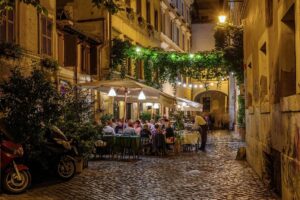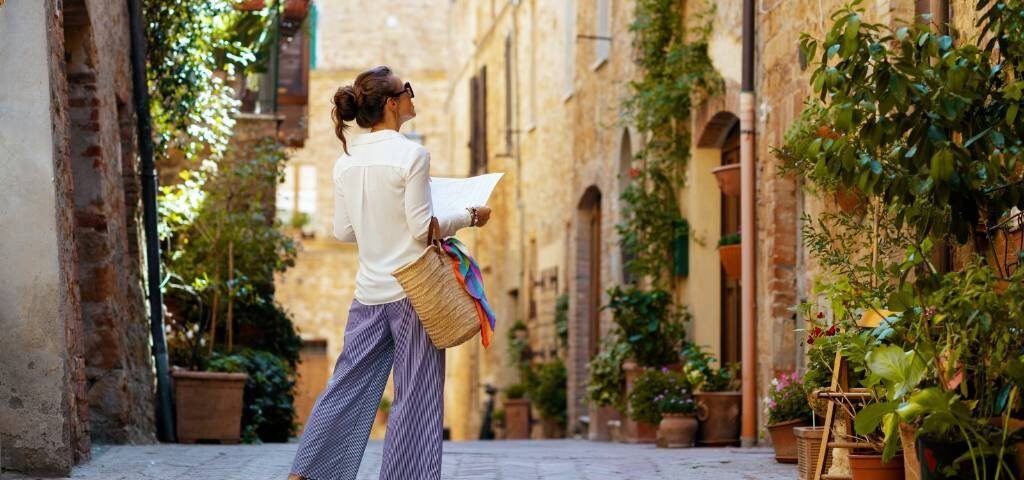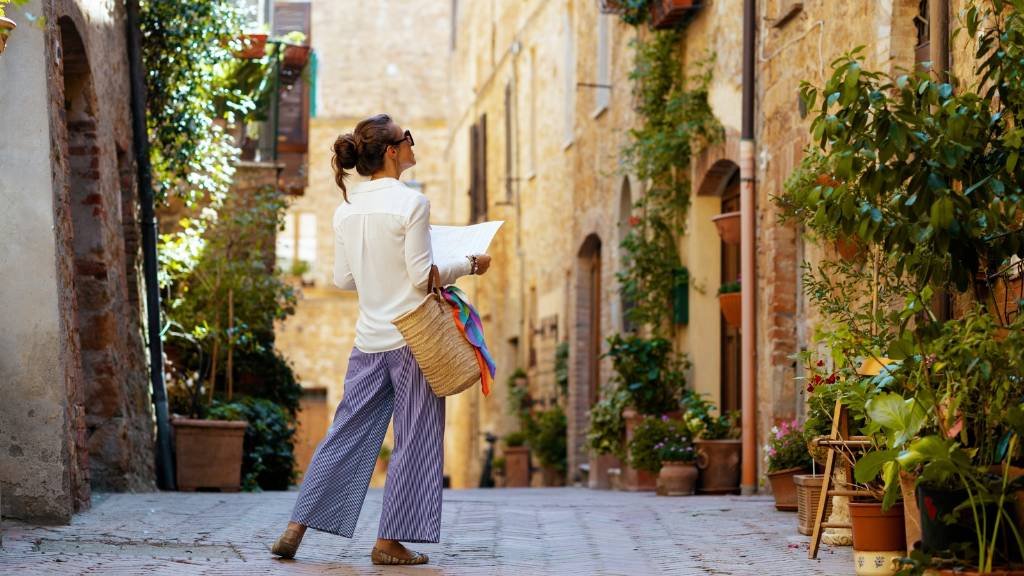Dateline: Montefiridolphi, Italy
The fox emerged from the olive groves, crossed the outdoor terrace, and slowly walked through the open door into the dining room where I was hosting my group’s arrival dinner just four nights ago.
We are staying in a series of restored Tuscan farmhouses on the Åntonori family wine estate. The fox wasn’t on the itinerary. Our Italian hosts immediately walked up and fed him some rather good pappardelle with a bit of rabbit sauce. He took what he could, looked us over and preceded to walk back out to the terrace to sit in his regular spot to finish his snack. It turns out that he makes an appearance just about every night at 10:05 pm.
He dined alone while the restaurant cat stared him down from a safe distance. They had learned to coexist.
The client sitting next to me wondered if “an animal will be joining us at all of our future meals”.
Thirty-four years ago, I was summoned before a board and informed that I had been granted a sum of money to launch a new school in Europe. I began my planning in the South of France, but karma and cost soon brought me to the Tuscan hills. I lived in a large villa for six years, with the company of my teaching staff and 75 or so American high school seniors.
Time passed and some twenty years ago, I figured out a way to return to the neighborhood on a regular basis. The result was a corporate division dedicated to Culinary and Lifestyle tours of Italy.
Yesterday we went to the walled town of San Gimignano. The wonderful thing about the views out of the windows at restaurant La Cisterna is that nothing has changed. No chain stores or little box housing developments dot the magnificent hillsides. And that is really what makes so much of Europe, and particularly Italy, so wonderful. From the first time you see it and fall in love you can sleep secure in the knowledge that when you return, years later. it will not have changed.
The red rooftops of any new homes in the villages must conform to antiquity, only seven primary Tuscan colors are approved for painting the outside stone facades.
It was market day. I wandered through the belts and the bras and the socks toward the back of the stall area. I was looking for someone. He was there, standing in his open truck, swatting away a few bees. And as I approached, he noticed me but did not remember. He reached down and ever so delicately sliced a piece off the whole roasted pig that lay on the wood slab before him. Flavored with fennel, rosemary, and sage, the roast pork panini sandwich brought back a flood of memories. I had last bought a sandwich from him in 1971.
On Sunday, we took our group off to tour the home of Machiavelli in San Caasciano. We walked across the road to dine on a “lite” lunch of real tuscan bruscetta (topped with chicken liver pate- not tomatoes), olive oil marinated roasted chicken and grilled Florentine steaks.
Later we drove to Impruneta where we entered the small, clay covered workshop of Mario Belli. He is not very used to guests but he explained his craft through our interpreter, and decorated and shaped glassware on an ancient potters wheel in front of our eyes. He has been in this workspace, doing this work for 52 years. There are no apprentices to be found. The work is too delicate, the workspace too primitive to attract the young.
Last night, we went to a small hamlet high in the hills not far from Radda in Chianti. Sixty-three folks live in this village, among them a mother and daughter known throughout the region for their traditional cooking skills. The hamlet has two businesses, a bar/restaurant and a rather excellent small wine and olive oil shop specializing in the excellent local products. I kept staring at the group of mature villagers, none, I was told, under eighty, who were laughing and recounting the events of the day – no doubt speculating a bit about our group of twenty-four. They laughed, they poked fun at one another, and they glowed in the approaching twilight with that special look reserved for the deeply contented.
The cook and her mother taught us how to cook while adding several liters of fine red wine to nearly every dish. Then, under a canopy of stars, sitting on a terrace overlooking the hamlet’s vineyards, the lights of small villas visible in the distanced, the residents of this village presented plate upon plate of their own dishes, the food they enjoy in their own homes.
As we hugged the villager’s goodnight and I saw tears in the eyes of some of my friends here, I remembered, once again, that travel ought to be, in its truest sense, a search for authenticity.

Dateline: Florence, Italy
Florence is best in the early spring or late fall. I like November when the olives are harvested and the tourists are gone. Well not really gone – just less obviously in control.
The 18th century French Novelist, Stendahl, wrote about the malaise that affects first-time visitors to the city. They are overcome by the amount of beauty and fine art, the reality of actually seeing that which they have heard described in history books. This physical malaise was known as tourist disease but, somehow, it has always been associated with the first-time visitor to Florence.
The New York Times moved the theory along by interviewing Dr. Magherini, the head of the Psychiatry Department at Santa Maria Nuova Hospital in Florence. In 1988 She admitted that her hospital had treated more than “100 cases” of this psychiatric trauma with symptoms such as a loss of reality, insomnia, guilt, and loss of identity, as some of the accompanying symptoms. Most of the victims were, of course, Americans. The French are not going to get dizzy looking at Italian architecture.
With a name and a validation, readers of the Times, and others, now imagine they are experiencing this disease while standing in front of the real David in the Galleria or the Baptistery opposite the incredible Duomo.
Eight years ago, I was summoned to an Italian Government conference to be held in Florence. It’s purpose was to discuss the state of tourism and how more visitors could be enticed to visit Italy.
I went, even though I couldn’t imagine more visitors to Florence, Venice, or Rome unless Merck came up with a pill that enabled tourists to sleep standing up, side by side.
The meeting was held inside the City Hall, Palazzo Vecchio in the huge Salone dei Cinquecento the work of Vasari in the mid 1500’s. I must confess to being overcome by my surroundings and exhibiting at least two of the symptoms of the malaise.
On this trip, I decided to avoid emotional trauma by housing our group of foodies and culture mavens just outside the city center. We’ve been holed up for the past several nights at Villa La Vedetta, a restored Villa just off the Piazza Michelangelo, thought to be the best view of Florence. This lovely property has just eighteen rooms so we sort of owned it. The terrace was the size of two basketball courts, and just below us, we could see the entire city center laid out like a miniature storyboard of world cultural icons. The siena, russet, and burnt butter colors shimmered off a series of blue sky days and red sky nights.
Tonight is my last night in the city environs. We move to the Italian Lake District tomorrow. So it is sunset as I sit and write, alone on the terrace. The colors below me are changing as the sky darkens and the lights of the city illuminate the Church of Santa Croce, the Uffizi, and the walls of the Pitti Palace.
It all brings back memories, and although I have been leading a group of travelers, I am alone, for the moment.
Suddenly I hear my name called from the rooftop. One of my favorite couples has found an unknown stairway leading to the rooftop. They direct me up to their special perch, a small area with a table and four chairs surrounded by a low wall.
The table is filled with salami and cheese from Falonori, the world’s oldest salami store in nearby Greve which we had visited that that morning. There were several bottles of super Tuscans and before us, a carpet filled with the still functioning relics of the Renaissance. Somewhere in the distance church bells started ringing, and the sound of laughter rose up to the rooftop, mixed with a ballad by Gigi D’Alessio.
And I started swooning, overcome by the beauty of where I was and what I was seeing. I had, once again, caught the disease Stendahl had described. And despite numerous trips to this wonderful place, I know of no cure.


